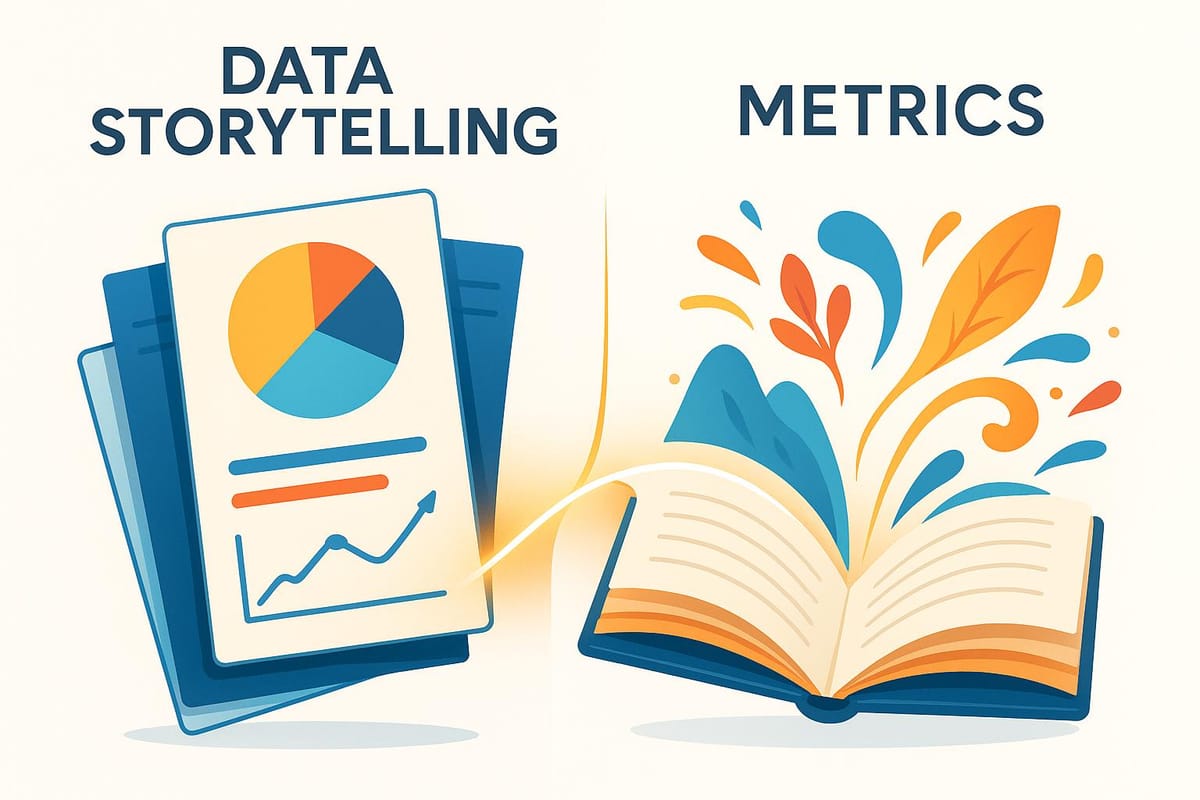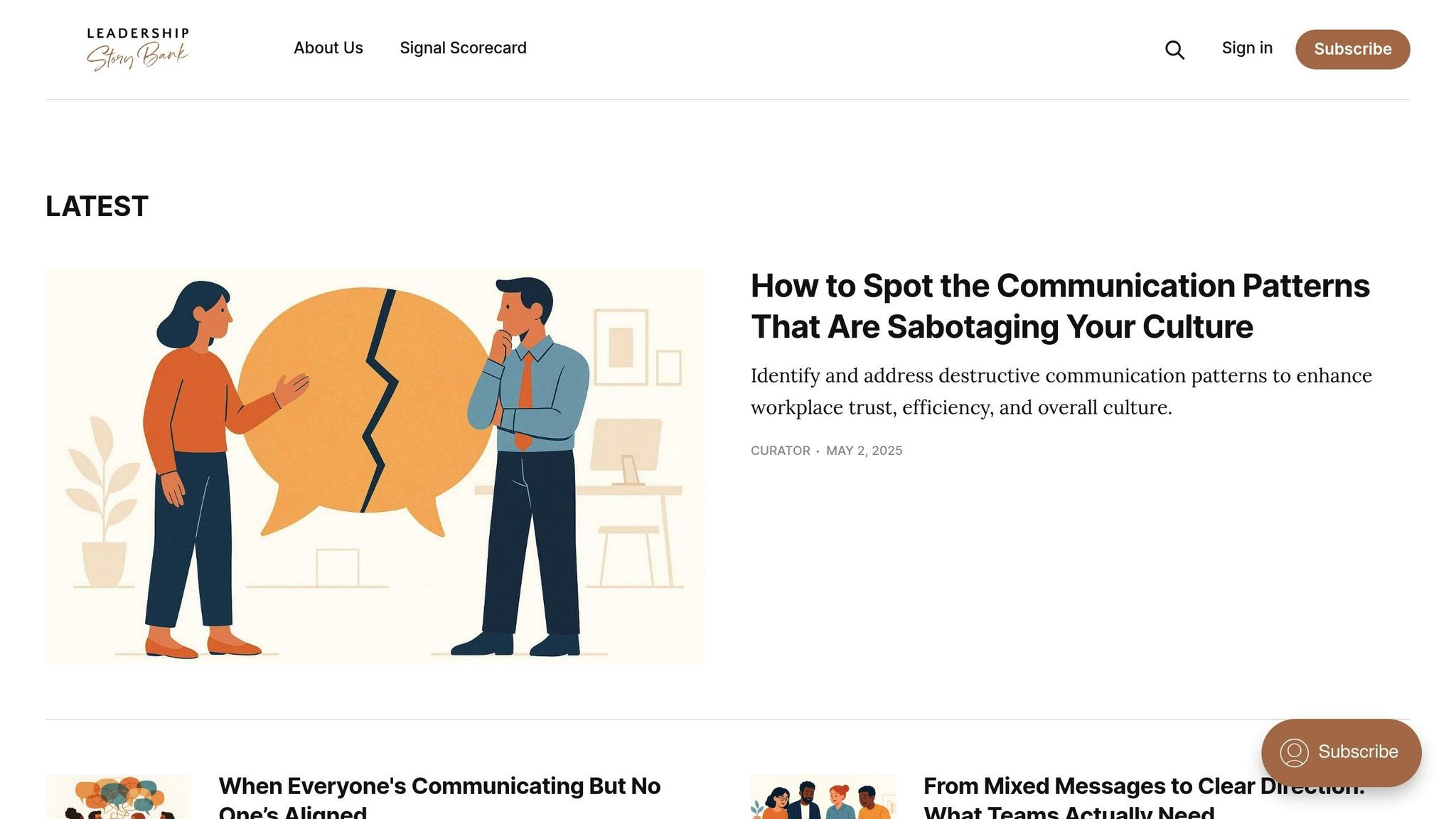Data Storytelling vs. Metrics: What Matters Most?
Explore the balance between data storytelling and metrics to enhance decision-making and inspire action in your organization.

Want to make better decisions and inspire action? Combine data storytelling and metrics. Here's why:
- Data storytelling adds emotional context, making insights relatable and memorable.
- Metrics provide hard facts, ensuring decisions are grounded in evidence.
Key Differences:
| Aspect | Data Storytelling | Metrics |
|---|---|---|
| Purpose | Adds meaning through narratives | Delivers measurable evidence |
| Style | Relatable and emotional | Precise and logical |
| Impact | Inspires action | Supports informed decisions |
| Engagement | Appeals to emotions | Appeals to logic |
When to Use:
- Stories: Change management, simplifying complex ideas, uniting teams.
- Metrics: Performance reviews, financial reporting, tracking progress.
The best leaders balance both. Use storytelling to connect emotionally and metrics to provide clarity. Together, they drive engagement, understanding, and results.
Stories Beat Statistics: The Power of Data Storytelling
How Data Stories Drive Action
Let's dive into how combining data with storytelling not only captures attention but also motivates people to take action.
3 Key Features of Impactful Data Stories
Turning raw data into actionable narratives requires three main ingredients:
- A clear narrative structure: Walk your audience through the insights step by step.
- Engaging visuals: Use charts or graphs to highlight important trends.
- Relevant context: Link the data to real-world challenges and goals your audience cares about.
Connecting with Your Audience
To make your data resonate, focus on creating an emotional connection. Think about your audience's struggles, ambitions, and daily experiences. When you present numbers in a way that aligns with their reality, the data becomes more relatable and impactful.
Examples of Data Storytelling in Practice
What makes data storytelling so effective is its ability to clarify information and inspire action. When you combine storytelling techniques with data, you guide your audience toward decisions and solutions. Here are some principles to follow:
-
Start with the "Why"
Begin by explaining why the data matters. Show its relevance right away. -
Reveal Insights Gradually
Share findings step by step to keep your audience engaged and make the story flow naturally. -
End with Clear Actions
Wrap up by connecting the insights to specific actions your audience can take. This turns understanding into results for your organisation.
Strong data stories don’t just inform - they inspire. Next, we'll look at how precise metrics can strengthen these narratives by grounding them in measurable results.
Metrics as Decision Tools
Why Numbers Matter
Stories can captivate, but metrics back up decisions with hard facts. They provide a way to measure performance, track progress, validate choices, and ensure goals are on track.
Here’s what strong metrics do:
- Provide an objective view of performance
- Highlight progress over time
- Support strategic decision-making
- Clearly define what success looks like
Presenting Clear Metrics
Clear presentation of metrics is essential. Avoid overwhelming your audience and always provide the right context.
Here are some key tips for presenting metrics effectively:
- Focus on 3–5 key performance indicators (KPIs) that align with your goals.
- Compare your metrics to historical data or industry standards.
- Stick to one measurement format for consistency.
- Highlight notable changes or trends in the data.
| Do | Don’t |
|---|---|
| Show trends over time | Mix unrelated time periods |
| Use clear, understandable labels | Include overly complex formulas |
| Highlight important comparisons | Present raw data without context |
| Keep formatting consistent | Overload with too many metrics |
Metrics That Drive Results
Metrics that truly make a difference are those that connect directly to business outcomes. Using KPIs and ROI analysis helps leaders see the impact of their choices.
Focus on metrics that:
- Support strategic goals by showing progress toward key objectives.
- Encourage actionable change through clear performance indicators.
- Aid decision-making by balancing predictive and historical data.
When to Use Stories vs. Metrics
Best Times for Stories
Stories are powerful tools for creating an emotional connection and inspiring action. Here are the situations where they work best:
Change Management Initiatives
When organisations go through changes, stories help explain the purpose behind the shift and encourage emotional investment.
Breaking Down Complex Topics
Stories make difficult concepts easier to grasp and remember by presenting them in a relatable way.
Uniting Teams
A well-told story can bring teams together by highlighting a shared vision or purpose.
Best Times for Metrics
While stories connect on an emotional level, metrics offer clarity and accountability. Use metrics in these scenarios:
Performance Reviews
Metrics like KPIs provide a clear, unbiased view of achievements and areas for improvement.
Financial Reporting
When presenting budgets, forecasts, or quarterly results, precise numbers are essential.
Tracking Progress
Metrics allow you to measure progress toward goals with concrete, reliable data.
Stories vs. Metrics Quick Guide
| Context | Stories | Metrics |
|---|---|---|
| Change Management | ✓ Explains and engages | × Lacks emotional depth |
| Performance Reviews | × Too subjective | ✓ Offers measurable insights |
| Complex Topics | ✓ Simplifies and clarifies | × Can feel overwhelming |
| Financial Reports | × Too vague | ✓ Provides accuracy |
| Team Alignment | ✓ Creates shared purpose | × Misses the human connection |
| Progress Updates | × May not provide enough detail | ✓ Tracks tangible outcomes |
This table serves as a quick reference for deciding when to use stories or metrics, depending on the situation.
Great leaders know how to balance emotional impact with factual accuracy. By understanding when to use stories and when to rely on metrics, you can engage both the hearts and minds of your audience, ensuring effective communication and decision-making.
Conclusion: Mastering Both Skills
Balancing storytelling with data isn't just a skill - it's a necessity for effective leadership. Here's a quick recap of the essentials.
Key Takeaways
Metrics Need Context
Data alone doesn't inspire action. Presenting numbers within a compelling story helps your audience grasp their importance and relevance.
Stories Build Connection
While data shows the facts, stories create an emotional link that makes those facts memorable and actionable.
Tailor Your Approach
The best leaders adjust their communication style based on:
- Who they're speaking to
- The complexity of the information
- The purpose of the message
- Where the audience is in the decision-making process
Always shape your message to fit the situation and the people you're addressing.
Leadership Story Bank: Your Next Step

If you're ready to fine-tune your ability to combine storytelling and data, consider diving into our specialised training programmes.
"Effective storytelling transforms leadership communication, making complex ideas relatable and inspiring action through emotional connections." - Leadership Story Bank
These programmes are designed to help you:
- Craft Change Narratives: Develop stories that clarify and motivate, especially during times of organisational change.
- Simplify Complex Data: Learn to present complicated metrics in a way that resonates with any audience.
- Unite Through Storytelling: Use the power of narrative and data to align teams and drive shared goals, improving overall results.
Balancing numbers and storytelling takes practice, but with the right tools and guidance, it can become second nature.
FAQs
How can leaders balance storytelling and metrics to make better decisions?
Leaders can achieve better decision-making by combining data storytelling with measurable metrics. Storytelling helps to create emotional connections, making data more relatable and memorable, while metrics provide the concrete evidence needed to support decisions.
A balanced approach involves using stories to highlight the context and significance of the data, ensuring it resonates with the audience, while also presenting clear, actionable metrics to back up the narrative. This combination not only inspires teams but also builds trust and credibility, enabling leaders to influence effectively.
What mistakes should I avoid when presenting data without storytelling?
Presenting data without storytelling can lead to several pitfalls that reduce the impact of your message. One common mistake is overwhelming your audience with too many metrics or complex charts, which can make it difficult for them to grasp the key insights. Instead, focus on the most relevant data points that support your narrative.
Another issue is failing to connect the data to a larger context or purpose. Without a clear story, your audience may struggle to understand why the data matters or how it relates to their goals. Crafting a compelling narrative around the data ensures it resonates emotionally and intellectually.
Finally, avoid using jargon or overly technical language. While precision is important, clarity is key to engaging your audience. Use simple, relatable terms to make your data accessible and impactful.
When should data storytelling take precedence over metrics, and why is it important?
Data storytelling should be prioritised when the goal is to create an emotional connection, inspire action, or communicate complex insights in a way that resonates with your audience. While metrics provide measurable evidence, storytelling helps to contextualise the data and make it more relatable, especially when addressing diverse stakeholders or leading through change.
For leaders, balancing storytelling with metrics is crucial. Stories can bring clarity and meaning to numbers, ensuring the message is not only understood but also remembered. By weaving narratives around data, leaders can motivate teams, influence decisions, and drive impactful outcomes.
